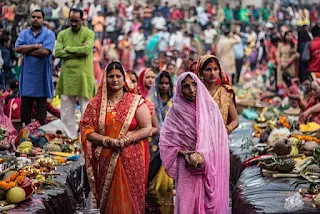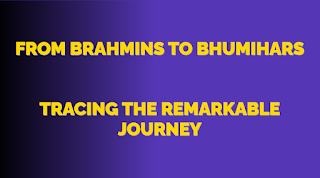Discover the rich heritage and significant contributions of the Bhumihar caste. Explore their cultural traditions, influential personalities, and historical significance in India. Learn about their social status, educational achievements, and the impact of Bhumihar caste in fields such as politics, literature, and art. Uncover the customs, rituals, and social fabric that shape the identity of the Bhumihar community, making them an integral part of Bihar's cultural tapestry.
 |
| Bhumihar caste: Education and professional achievements |
The Bhumihar caste is one of the prominent upper-caste communities in India, known for their historical significance and influential presence. This article aims to delve into the socio-historical journey, cultural nuances, and contributions of the Bhumihar community in a comprehensive manner.
 |
| Bhumihar caste history and culture |
Historical Origins and Social Standing:
The Bhumihar caste traces its origins to the ancient Brahmin lineage, believed to have emerged as a distinct community during the medieval period. Bhumihar community history Initially, they were landowners and cultivators, thus earning the title "Bhumihar," which means "Landowners" or "Lord of the Earth." Explore the evolution of their social standing, from being esteemed Brahmins to acquiring a distinct identity within the caste system.Geographical Distribution and Demographics:
Highlight the geographical distribution of the Bhumihar community, primarily concentrated in the states of Bihar, Uttar Pradesh, and Jharkhand. Discuss the population demographics, their settlement patterns, and regional variations in customs and traditions.Cultural Traditions and Festivals:
Bhumihar caste traditions Delve into the rich cultural traditions of the Bhumihar caste, including their unique customs, rituals, and festivals. Explore the significance of festivals such as Chhath Puja, Saraswati Puja, and Holi in their cultural fabric, reflecting their religious and social practices.Educational and Intellectual Contributions:
Examine the historical role played by Bhumihars in education and intellectual pursuits. Highlight the achievements of notable Bhumihar scholars, writers, and leaders who have contributed significantly to various fields, including literature, politics, and academia.Social and Political Influence:
Discuss the social and political influence of the Bhumihar community. Explore their involvement in governance, public administration, and political movements, shedding light on influential Bhumihar leaders who have made a mark in Indian politics.Challenges and Modern Outlook:
Address the challenges faced by the Bhumihar community in contemporary times. Discuss issues such as social inequality, economic disparities, and the need for social reforms. Analyze the changing dynamics within the caste, including increasing educational opportunities, empowerment of women, and efforts towards social upliftment.Contributions in Agriculture and Entrepreneurship:
Highlight the historical role of Bhumihars in agriculture, landownership, and agrarian society. Discuss their contributions to agricultural development and their transition towards entrepreneurship and professional fields in recent times.Social Organizations and Community Initiatives:
Explore the role of Bhumihar social organizations in fostering community welfare, cultural preservation, and educational upliftment. Discuss initiatives taken by these organizations to address social issues, provide scholarships, and promote cultural awareness among Bhumihars.Bhumihar Weddings and Rituals:
Provide insights into Bhumihar wedding ceremonies, customs, and traditions. Discuss the significance of rituals like Haldi, Mehendi, and Kanyadaan, which form an integral part of Bhumihar matrimonial ceremonies.Future Outlook and Challenges:
Conclude the article by discussing the future prospects and challenges faced by the Bhumihar caste. Highlight the need for social reforms, inclusive growth, and the preservation of cultural heritage while promoting equality and social justice.
Conclusion:
The Bhumihar caste has left an indelible mark on Indian society with its historical legacy, cultural traditions, and contributions to various fields. Understanding the socio-historical journey of the Bhumihar community provides valuable insights into India's diverse caste fabric and their evolving role in shaping the nation's social, cultural, and political landscape.Frequently Asked Questions (FAQs)
Certainly! Here are some frequently asked questions (FAQs) about the Bhumihar caste:
What is the Bhumihar caste? The Bhumihar caste is an upper-caste community in India. They are believed to have originated from ancient Brahmin lineage and are primarily landowners and cultivators.
Which regions in India are predominantly inhabited by the Bhumihar community? The Bhumihar community is mainly concentrated in the states of Bihar, Uttar Pradesh, and Jharkhand. However, they can also be found in other parts of India.
What is the significance of the term "Bhumihar"? The term "Bhumihar" is derived from the words "Bhumi" meaning land and "Har" meaning lord or owner. It signifies the historical association of the community with landownership and agriculture.
What are the cultural traditions and festivals celebrated by the Bhumihar caste? The Bhumihar community celebrates various festivals such as Chhath Puja, Saraswati Puja, Holi, and other religious and social events. They have unique customs and rituals associated with these festivals.
What are the notable contributions of the Bhumihar community? The Bhumihar community has made significant contributions to education, literature, politics, and other fields. Many renowned scholars, writers, and leaders belong to this caste and have played influential roles in shaping society.
How has the Bhumihar community evolved in modern times? The Bhumihar community has undergone changes in recent times, with an increased emphasis on education, entrepreneurship, and social reforms. Efforts are being made to address social inequalities and empower marginalized sections within the community.
Are there any social organizations or initiatives specific to the Bhumihar community? Yes, there are social organizations and initiatives dedicated to the welfare and upliftment of the Bhumihar community. These organizations work towards preserving cultural heritage, providing educational opportunities, and promoting community development.
What are the challenges faced by the Bhumihar caste? Like any other community, the Bhumihar caste faces challenges such as social inequalities, economic disparities, and the need for social reforms. Efforts are being made to address these issues and ensure a more inclusive society.
Are there specific marriage customs and rituals followed by the Bhumihar community? Yes, the Bhumihar community has unique marriage customs and rituals. These include ceremonies like Haldi, Mehendi, Kanyadaan, and other traditional practices that form an integral part of Bhumihar weddings.
How does the future look for the Bhumihar community? The future of the Bhumihar community holds promise, with increased educational opportunities, empowerment of women, and social initiatives. However, there are still challenges to be addressed, and ongoing efforts are focused on fostering inclusive growth and preserving cultural heritage.
Note: The responses provided are based on general information and may vary within different subgroups and regions of the Bhumihar caste.
Also Read More About Jaat Caste : Explore the rich history and cultural heritage of the Jaat caste, known for their agricultural expertise and social traditions.
Read More : Bhumihar Brahman Ekta Manch